Bulletin – March 2018 Australian Economy Perceptions of Job Security in Australia
- Download 731KB

Abstract
A concern that low job security is constraining wage growth has been expressed in many countries. Using data on Australian households over time, this article finds that workers' perceptions of their own job security have declined in recent years. This deterioration has occurred across many job and personal characteristics. These weaker job security perceptions have provided a small drag on wage growth.
Introduction
A worker's perception of their own job security may influence how hard they bargain over their wages. Several factors may contribute to these job security perceptions, including labour market conditions, the type of employment contract, union membership status, as well as the potential for their work to be automated or sent offshore. Shifts in these factors could make workers feel less secure in their job and so more likely to accept smaller wage rises. The concern that low job security is constraining wage growth has been expressed across a number of advanced economies recently (Haldane 2017; Lowe 2017), as well as in the United States two decades ago (Greenspan 1997). This article documents the decline in perceptions of job security in Australia, the cyclical and structural factors that have driven it, and shows that it explains a small part of the recent weak wage growth.
This article focusses on perceived (or self-assessed) job security, which is someone's subjective expectation that they will retain their job. These beliefs – whether justified or not – can influence wage bargaining behaviour. For instance, if an employee believes that their job could be moved offshore, they may accept lower wage rises to encourage their employer to keep the job onshore. It does not matter whether or not the job is eventually moved, because it is this fear of job loss that would keep wage growth contained. This is in contrast to actual (or objective) job security, which is the likelihood that a worker does hold on to their job. Actual job insecurity is typically equated with jobs that have relatively high turnover or are temporary in nature. In recent years, there has been little change in actual job security (Borland 2017). Determinants of objective job security, such as casualisation and labour market conditions, can contribute to perceptions of job security, though personal circumstances, popular narratives, expectations of the future, and domestic or international events may also play a role.
Measures of Job Security
The Household, Income and Labour Dynamics in Australia (HILDA) Survey contains several measures of self-assessed job security, as well as labour income and a vast array of personal and job characteristics from 2001 to 2016.[1] The panel design of the dataset also allows us to track how an individual's perceived job security changes over time and influences their wage growth in the following year. We define job security as a worker's self-assessed probability of keeping their job over the next year. The survey asks respondents who are currently working, ‘What do you think is the per cent chance that you will lose your job during the next 12 months?’, where job loss covers retrenchment, being fired or no contract renewal. The probability of job retention is then 100 less the stated probability of job loss. This measures perceptions of short-term job security, which should be more correlated with near-term wage outcomes, as opposed to concerns of future job loss through long-term changes in the structure of the economy.
Workers tend to have a high rate of self-assessed job security; the probability of expected job retention averages 89 per cent across the whole sample period (Graph 1). Almost 60 per cent of workers said they had a 100 per cent chance of retaining their job in the next 12 months. For those who have some uncertainty around job loss, the probability they assign to job retention is still high, with less than 4 per cent of the population expecting more than a 50 per cent chance of job loss. This job retention measure is consistent with an alternative HILDA survey question on ‘job security satisfaction’, which asks how satisfied one is with their job security on a scale of 0–10. The measures from the HILDA Survey also closely match a measure calculated using data from the ABS Labour Force Survey; the ABS measure also highlights that only a small share of the workforce has concerns about holding on to their job over the following year.
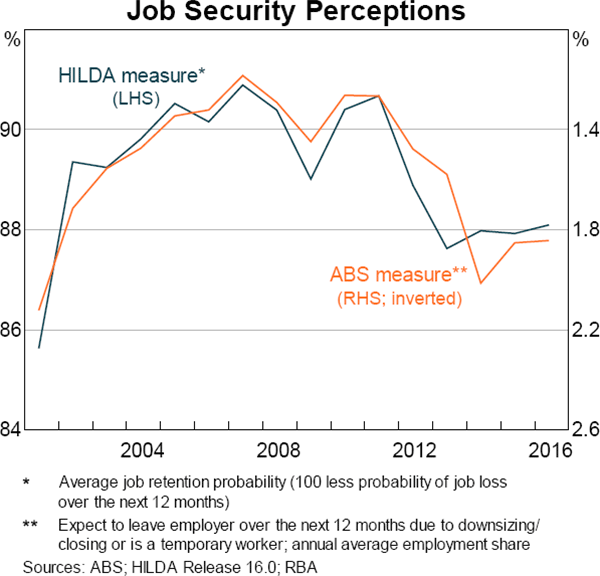
While this series does not vary much, perceptions of job security appear to move in line with changes in overall labour market conditions. Not surprisingly, job security is relatively low when there is ample spare capacity in the labour market or underutilisation in the economy. Low job security in 2001 appears to reflect the brief spike in the unemployment rate and slowdown in growth at the time (Graph 2). This suggests that cyclical factors are likely to explain much of the movement in job security. Also, wage growth tends to be lower when workers had felt less secure the year earlier. This holds for ABS measures of aggregate wage growth as well as our measure of wage growth using the HILDA survey (described below). As Bishop and Cassidy (2017) note, based on this simple correlation, it is unclear whether perceptions of job security can help explain movements in wage growth over and above general labour market conditions. These issues are explored in this article.
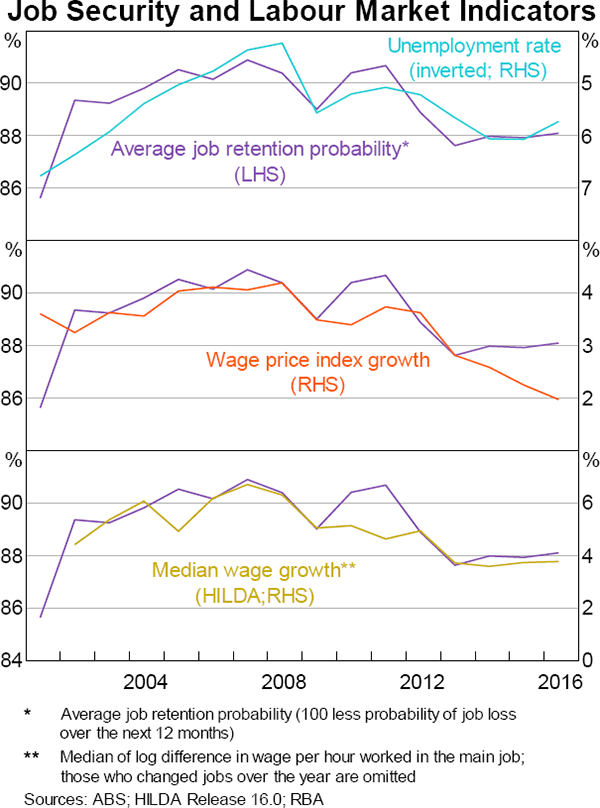
Factors Related to Job Security
This section explores how economic conditions, structural factors and individual characteristics affect perceptions of job security in Australia. The variable of interest – the self-assessed probability of job retention – is highly skewed, with well over half of workers having absolute certainty (i.e. 100 per cent chance) that they will keep their job over the year. To examine the determinants of job security, we transform the probability measure into a dummy variable. It is equal to 1 if a worker is 100 per cent sure of retaining their job over the next year, and 0 otherwise. This makes the modelling of this highly skewed probability variable more straightforward.
Perceived job security can be influenced by factors such as industry sector, occupation and work arrangements, as well as more general concerns about globalisation and automation (see ‘Box A: Measuring Trade Exposure and Automation Risk’).[2] We find that perceived job security is lower in industries that are more exposed to international competition (Graph 3). This finding can help explain the lower job security in the goods production sector, the industries of which have quite high import penetration ratios. The decline in perceptions of job security in recent years is a touch larger in more trade exposed industries, but generally appears to be broad based across all industry sectors. The fall in job security perceptions in business services has occurred despite strong employment growth in that sector, which suggests that labour market conditions are not the only driver of job security concerns.
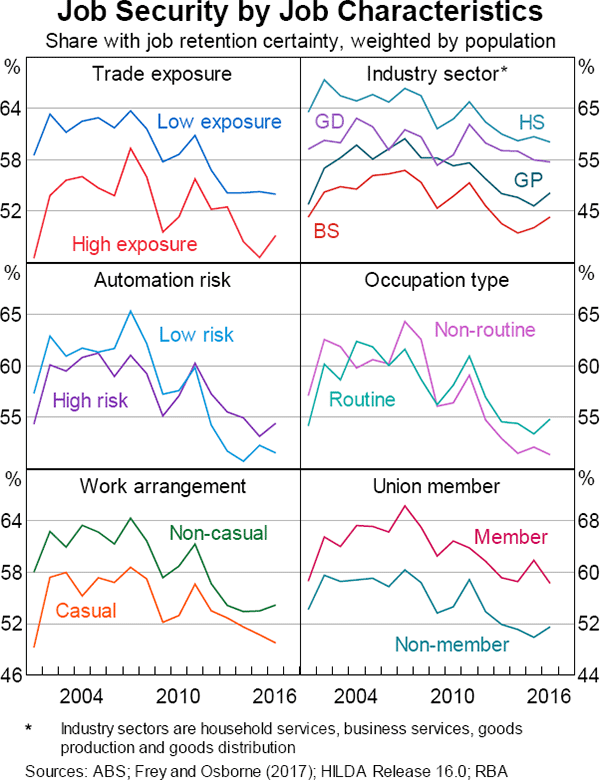
Workers in occupations with a high risk of automation reported greater job security fears prior to 2011. However this relationship has reversed in recent years as the fall in job security has been more pronounced for those in low-risk occupations. As expected, the perceived job security of those in routine occupations matches the trend seen in occupations with a high automation risk. The decline in job retention certainty has been broad based across different types of occupations, although a little steeper for those in non-routine roles. As expected, workers in casual roles report lower job security than those in non-casual roles. There is only a small difference in the job security of part-time and full-time workers. Union members feel more secure in their job, relative to non-union members. Those that are satisfied with their hours have higher job security than those wanting fewer or more hours, but concerns about job security have declined for both types of workers. Finally, those in regions with higher unemployment on average tend to have lower job security.[3]
Despite some differences in the level of job security perceptions, the decline has occurred across a range of job characteristics, regardless of industry, occupation, contract type or union membership. The decline has also been broad based across a range of personal characteristics, such as age, sex and educational attainment, as well as across most states. Overall, these patterns suggest that job and personal characteristics influence the level of perceived job security, but that the decline has been experienced across the board. Examining the alternative job security satisfaction variable yields a similar conclusion (see Appendix B).
Model results
The descriptive analysis above provides insights into the factors that are associated with job security perceptions, but the correlations between these factors make it difficult to discern their relative importance. To resolve this, we estimate a model of job security, which makes it possible to isolate the effect of each factor by controlling for all other variables in the regression model (see Appendix A for the full model results).
The results confirm that labour market conditions are an important influence on job security. Higher unemployment modestly contributes to lower job security, where a 1 percentage point rise in the unemployment rate is associated with a 1 percentage point fall in the probability of feeling certain about job retention. Those who would prefer more hours have a lower expectation of job retention. This suggests underemployment may weigh on feelings of job security, although those wanting to work fewer hours also had low job security. Overall, part of the fall in job security during the post-mining boom period can be explained by the weaker labour market.
Trade exposure and automation have the expected significant negative relationship with perceived job security. An industry with no exposure to international competition has job retention certainty about 3 percentage points higher than one in which imports make up around one-third of an industry's total supply (such as some of the manufacturing industries). After controlling for trade exposure and other factors, those in the goods production and business services sectors still have relatively low perceptions of job security, with those in household services having relatively high security. The average likelihood of feeling certain about job retention falls 3 percentage points when moving from an occupation with no automation risk to one that has the highest likelihood of being automated. Once automation risk is controlled for, being in a routine or manual occupation contributes to higher job security, in contrast to what is suggested by the summary statistics.
Regarding other job and personal characteristics, those that are associated with higher job security include: working full time, having a permanent position, having longer tenure, being female, being older, having less formal education and living outside a capital city.[4] The effect of union membership on job security is not statistically significant. Thus, the difference in average job security perceptions between union and non-union members can be accounted for by their job and personal characteristics.
The model also includes dummy variables for each year, which capture any unobservable factors that are common across individuals and vary over time. These may include macroeconomic, legislative and international factors that cannot feasibly be captured in the model. The year dummy variables are estimated to be increasingly negative in recent years. This suggests that there are aggregate factors weighing on job security that are not being captured by the other variables in the model.
The model estimates reveal the average propensity to feel secure for each personal or job characteristic over time. However, these feelings of job security can and do change over time. These changes are called ‘within’ effects, which captures the change in the propensity to feel secure within a particular characteristic (such as being female or a union member). Additionally, the composition of the workforce will evolve over time, which can affect aggregate job security. For instance, an increase in the share of part-time employment would be associated with more people feeling insecure, and so lower overall job security, all else being equal. A shift in the labour market to jobs that are less likely to be automated will increase the share of people feeling secure. The effect that these compositional shifts will have on job security in aggregate is called ‘between’ effects. By estimating the model for each year we can disentangle the roles of the within and between effects on aggregate job security.
The decline in job security has been broad based across the characteristics we examine in the model, as highlighted by the persistently negative within-characteristics effect (Graph 4). Compositional change had been working in the opposite direction, with employment moving towards characteristics that generally make workers feel more secure, providing a boost to aggregate job security. The drag from perceived job security within characteristics has been growing since around 2004, with the offset from compositional shifts diminishing over the post-crisis period.
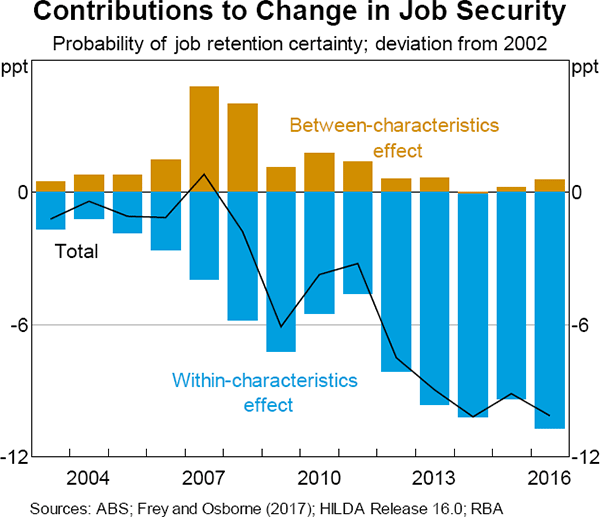
Box A
Measuring Trade Exposure and Automation Risk
Two factors that are commonly suggested to influence both actual job loss and perceptions of job security are globalisation and technological change. An industry's exposure to global trade can be measured using its import penetration ratio. These ratios are calculated as the import share of the total output supplied by an industry, and represent the foreign share of the competition that firms in that industry face in the domestic market. Data are available from the ABS input-output tables for each industry subdivision across a range of financial years, with data for any missing years interpolated linearly. The import penetration ratio of the manufacturing industry is relatively high and has been increasing over the past decade as domestic demand for manufactured goods is increasingly met by imports (Graph A1). The hospitality and professional services industries have also faced rising import penetration, whereas trade exposure in the education industry is lower and has declined somewhat in recent years.
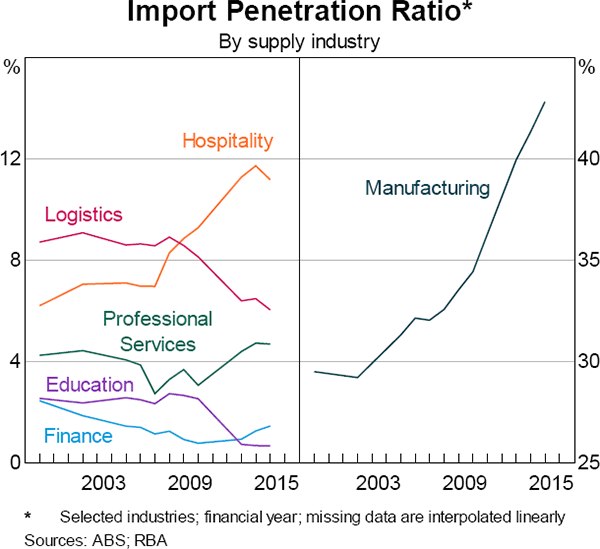
Overall, the import penetration ratios of most industry subdivisions have been increasing in recent years. However, the effect of this on the aggregate labour market has been offset by stronger employment growth in industries that are less exposed to international trade. As a result of this compositional shift, the trade exposure faced by the representative worker has been little changed over the past decade, having declined over several years prior to that.
Another source of job insecurity is the risk that technology could be used to automate tasks that were previously completed by skilled workers. We capture this risk using the computerisation scores devised by Frey and Osborne (2017). These scores measure the likelihood that an occupation's tasks could be automated using current computing technology.[5] We map these scores to the Australian unit group occupations to capture the potential for each of these jobs to be automated. The scores are not available over time and so we cannot evaluate how job security is being affected by the pace of technological change. As would be expected, routine occupations are the most at risk of automation, and non-routine cognitive jobs are the least automatable (Graph A2). As is the case with industries highly exposed to global trade, occupations that have a greater potential to be automated have been decreasing as a share of total employment in recent years (Edmonds and Bradley (2015)).
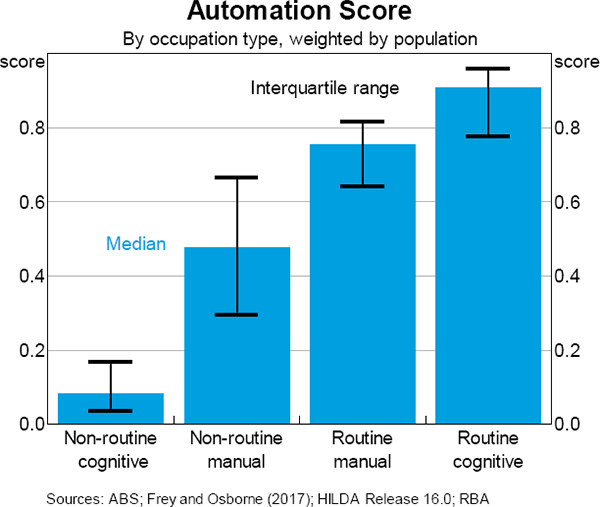
Job Security and Wage Growth
The HILDA Survey also allows us to assess whether concerns about job security can help explain the recent weakness in wage growth.[6] We use the survey data to calculate annual growth in average hourly earnings for each worker. It tracks aggregate wage growth measured by the ABS fairly well, although it has been more stable of late. Perceived job security is associated with higher wage growth the following year (Graph 5). However, the fall in wage growth in recent years has been experienced by both secure and less secure workers.
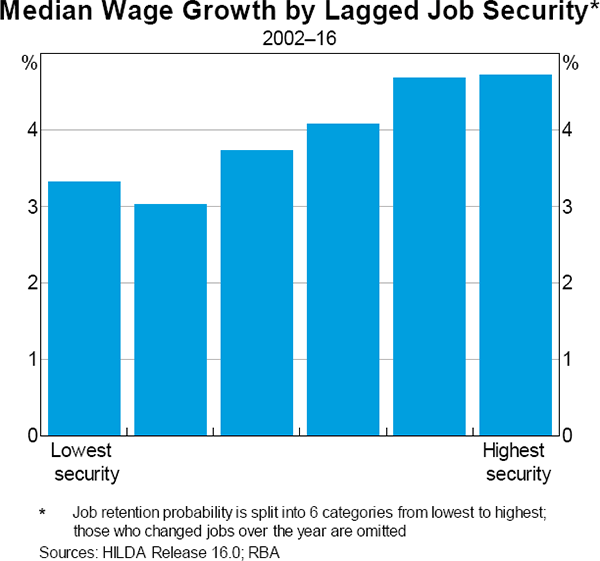
A model of annual hourly wage growth is estimated on the self-assessed probability of job retention. This model uses the continuous probability measure of job retention rather than the dummy variable measure from the previous section. This allows the model to capture the full information available in this variable, allowing for more detailed interpretation of the coefficient. The control variables included are the same as those used in the job security model above. The only difference is the inclusion of inflation – measured as growth in each capital city's consumer price index – as it should influence nominal wage growth. Therefore this model captures the effect of job security perceptions on wage growth over and above the many factors that can influence job security itself.[7]
The results show that a higher perceived likelihood of job retention has a statistically significant positive relationship with wage growth over the following year (see Appendix A for the full model results). A one standard deviation fall in job security (a change of 20 percentage points) is associated with a 0.3 percentage point decline in annual wage growth (Graph 6). However, this finding explains little of the fall in average wage growth observed in recent years. From 2010 to 2014 (the most recent peak and trough), average self-assessed job retention probability declined by only around 3 percentage points. This explains around 0.05 percentage points of the 1 percentage point fall in average wage growth over the corresponding period.
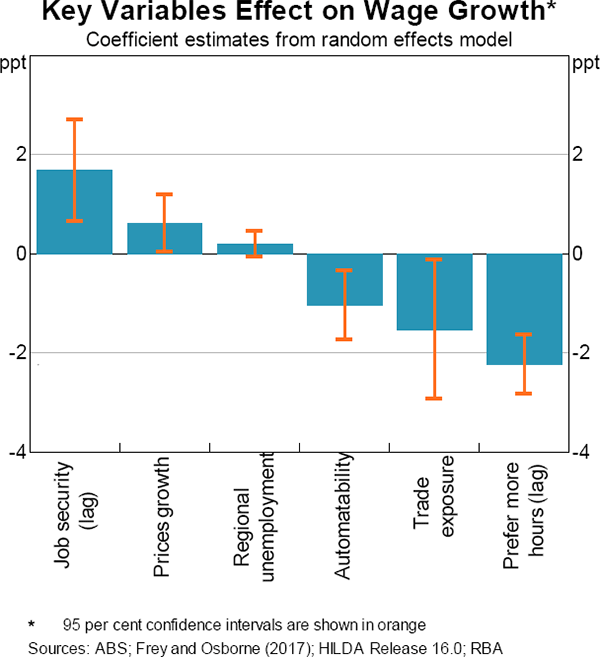
Automation risk and trade exposure are both found to significantly contribute to lower wage growth, though only automation risk remains significant across different model specifications. Despite the negative relationships, these measures have not been weighing on aggregate wage growth. This is because, in recent years, employment growth has been shifting away both from industries with a higher trade exposure and occupations that are more easily automated.
A number of variables that capture economic and labour market conditions were statistically significant. The coefficient on inflation is significant, and subdued inflation explains a noticeable amount of the fall in average wage growth in recent years. Those who would prefer more hours have lower wage growth in the subsequent year, which suggests an additional role of underemployment in suppressing wage outcomes. Surprisingly, unemployment has a weakly positive relationship with wage growth, though it does have the expected negative effect when the time dummy variables are excluded. In fact, these time dummies provide most of the explanatory power in the model, suggesting that changes in the local labour market are less relevant for wage growth than economic conditions at the national level.
Conclusion
Perceptions of one's job security are lower for those in casual work, areas of high unemployment, jobs with a high risk of automation and industries more exposed to global trade. However, aggregate conditions not captured in our model appear to be the key driver of job security concerns. The recent decline in perceived job security has been broad based across industries, occupations, job structure and personal characteristics. As such, we cannot pinpoint any one factor that has led to the decline in perceptions of job security.
We find that greater perceived job security is associated with higher wage growth, over and above the other factors in the model. A worker who is only 50 per cent sure that they will keep their job over the next year will have annual wage growth that is around 0.8 percentage points lower than a worker who is certain they will keep their job. As such, weaker job security perceptions have provided a small drag on wage growth in recent years. Nonetheless, the relatively small magnitude of the fall in average job security means that the decline in aggregate wage growth is mostly explained by other factors. Subdued inflation contributed to more of the decline in wage growth, with most of the fall explained by aggregate factors that are not directly captured in our model.
Appendix A
| Random Effects Probit | Random Effects Linear | |
|---|---|---|
| Job Security(a) | Wage Growth(b) | |
| Job security(c) | -- | 1.67*** |
| Economic Factors | ||
| Unemployment | −0.03*** | 0.19 |
| Trade exposure | −0.25*** | −1.54** |
| Automation | −0.08*** | −1.05*** |
| Consumer price index | -- | 0.60** |
| Industry Sector (base: goods production) | ||
| Business services | −0.09*** | −0.37 |
| Household services | 0.16*** | −1.03*** |
| Goods distribution | 0.08*** | −1.11*** |
| Other | 0.08** | −0.39 |
| Occupation Group (base: non-routine cognitive) | ||
| Routine manual | 0.17*** | 0.17 |
| Non-routine manual | 0.09*** | −0.44 |
| Routine Cognitive | 0.10*** | −0.41 |
| Job Characteristics | ||
| Lost a job in the past year | −0.28*** | 1.05 |
| Changed jobs in the past year | −0.09*** | -- |
| Promoted in the past year | 0.13*** | 3.60*** |
| Full time | 0.08*** | −4.09*** |
| Casual | −0.13*** | −0.10 |
| Temporary contract | −0.27*** | 0.54* |
| Work from home | 0.06*** | −0.86*** |
| Number of years in a job | 0.01*** | −0.02* |
| Trade union member | 0.01 | 0.09 |
| Firm-type (base: private sector) | ||
| NGO | 0.10*** | 0.14 |
| Public | 0.19*** | 0.50** |
| Firm-size (base: small firms) | ||
| Medium | −0.08*** | 0.08 |
| Large | −0.12*** | 0.14 |
| Hours preference (base: same hours) (d) | ||
| Fewer | −0.09*** | 2.89*** |
| More | −0.08*** | −2.23*** |
| Personal Characteristics | ||
| Female | 0.35*** | −1.34*** |
| Primary language is not English | −0.02 | 1.30*** |
| Born outside of Australia | 0.05 | −0.58*** |
| Outside a capital city | 0.15*** | −0.28 |
| Age (base: over 55s) | ||
| Under 25 | −0.32*** | 6.40*** |
| 25 to 39 | −0.23*** | 1.23*** |
| 40 to 54 | −0.15*** | −0.34* |
| Education (base: high school only) | ||
| Diploma or Certificate | −0.03 | −0.04 |
| University | −0.25*** | −0.30 |
| State (base: NSW) | ||
| Victoria | −0.02 | −0.59*** |
| Queensland | 0.02 | 0.17 |
| South Australia | 0.15*** | −0.31 |
| Western Australia | 0.35*** | 0.45 |
| Tasmania | 0.03 | −0.60 |
| Northern Territory | 0.03 | 0.43 |
| ACT | 0.07 | 0.97** |
| Year (base: 2002) | ||
| 2003 | −0.06** | 0.69 |
| 2004 | −0.04 | 1.14* |
| 2005 | −0.07** | 1.07* |
| 2006 | −0.10*** | 1.68*** |
| 2007 | −0.03 | 2.25*** |
| 2008 | −0.13*** | 0.17 |
| 2009 | −0.27*** | 1.55** |
| 2010 | −0.20*** | 0.52 |
| 2011 | −0.20*** | −0.14 |
| 2012 | −0.36*** | 0.91 |
| 2013 | −0.40*** | −0.39 |
| 2014 | −0.43*** | −0.69 |
| 2015 | −0.41*** | −0.02 |
| 2016 | −0.45*** | −0.13 |
| Constant | 0.60*** | 4.24*** |
| Pseudo log-likelihood | −56,415.32 | -- |
| R-squared | -- | 0.02 |
| Rho | 0.48 | 0.02 |
| Individuals | 18,621 | 13,706 |
| Observations | 100,255 | 65,837 |
|
***, ** and * represent statistical significance at the 1, 5 and 10 per cent level,
respectively Sources: ABS; Frey and Osborne (2017); HILDA Release 16.0; RBA |
||
Appendix B
The job security and wage growth models were estimated using random effects probit and linear random effects models, respectively. Alternative model specifications were also estimated to test the robustness of the results. For instance, for the job security determinants model, using the full probability measure (rather than as a dummy variable), led to similar results for the key variables of interest. In the wage growth model, the coefficient on job security was largely unchanged when we did not control for any other factors. This was also the case when we excluded those who were promoted over the year or when we excluded the year dummy variables. The relationship between job security and wage growth also appears robust to outliers, as the effect was similar under a median regression. The relationship between job security and wage growth was stronger when we model only the post-crisis period.
Selection models for both the job security and wage growth equations were estimated. Both of these variables are only observed for those in employment. So, the omission of those not in paid work, who are likely to have characteristics that are correlated with low job security, may lead to selection bias. The selection equation included variables such as unemployment history, health status, and being female with a dependent child under five, which are correlated with the probability of employment, but not job security or wage growth. In the job security model, most variables of interest had similar sign and magnitude, although the effect of unemployment was a bit smaller. In the wages model, the effect and statistical significance of job security was almost identical to the random effects model described in the text. This implies that selection bias is not a material concern in our analysis.
The wage growth model may suffer from reverse causality (endogeneity), where the expectation of a large wage rise may make one feel more secure in their job. An instrumental variables (IV) model was estimated using a subjective measure of life satisfaction as the instrument. This captures how optimistic one feels about life and is expected to be correlated with one's perceptions of their job security, but unlikely to be related to wage growth over the following period. Statistical tests confirmed this was a valid instrument. Using this instrument, tests showed that the results were not biased by endogeneity, so that an IV approach is not needed. Nonetheless, the effect of job security on wage growth was similar to the random effects model, but not statistically significant, under IV estimation.
We also examined an alternative measure of job security, called ‘job security satisfaction’, based on how satisfied one is with their job security on a scale of 0–10. We split the variable into high (8–10), medium (5–7) and low (0–4) job security satisfaction categories. The general trends and regression modelling (using a random effects ordered probit model) led to broadly similar results (Graph B1). Unemployment, trade exposure and automation have a negative relationship with job security. Those in routine manual roles had significantly lower perceived job security satisfaction, which is as expected but a different result to that of the job security certainty measure outlined above. Compositional change appears to have had a much larger positive effect prior to 2010, and the decline in job security since then was broad based across characteristics (that is, the within-characteristics effect dominates in the latter part of the sample, similar to the job retention measure). Using this measure in the wage growth model, we find that those with high and medium job security satisfaction have around ½ a percentage point higher wage growth than those with low satisfaction, but the result was (singularly and jointly) statistically insignificant. This is in line with the results of Dickerson and Green (2012), who find that probability measures of subjective job loss explain labour market outcomes better than ordinal measures.
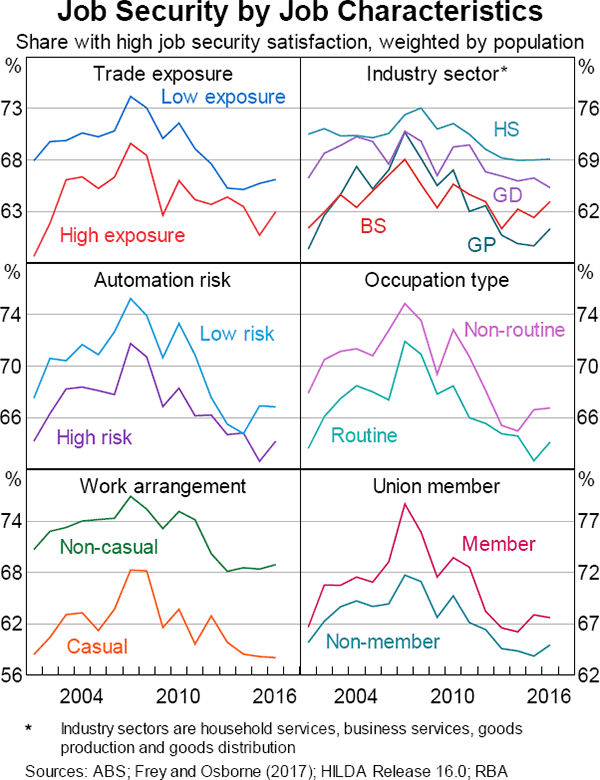
Footnotes
The authors are from Economic Analysis Department. [*]
This document uses unit record data from the Household, Income and Labour Dynamics in Australia (HILDA) Survey. The unit record data from the HILDA Survey was obtained from the Australian Data Archive, which is hosted by The Australian National University. The HILDA Survey was initiated and is funded by the Australian Government Department of Social Services (DSS) and is managed by the Melbourne Institute of Applied Economic and Social Research (Melbourne Institute). The findings and views based on the data, however, are those of the authors and should not be attributed to the Australian Government, DSS, the Melbourne Institute, the Australian Data Archive or The Australian National University and none of those entities bear any responsibility for the analysis or interpretation of the unit record data from the HILDA Survey provided by the authors. [1]
In the summary statistics, an industry is classified as having high trade exposure if the import penetration ratio is above 5 per cent, while an occupation has a high automation probability if the automation score is above 50 per cent. [2]
Unemployment rates are examined for the ABS major statistical regions. [3]
Some of these characteristics may be affected by selection bias. For instance, those groups with lower rates of labour market attachment – such as females and older workers – may leave the workforce if they cannot find secure employment, which would bias the results. This is examined in Appendix B. [4]
A shortcoming of the Frey and Osborne (2017) approach is that the automation scores depend on the initial subjective decisions about which tasks have the potential to be automated using current technology (Borland and Coelli 2017). The method also does not allow for technology to complement labour and change the nature of an occupation. Therefore, these scores may not accurately measure the likelihood for each occupation to be automated. Nonetheless, the scores are well suited to measuring general perceptions of technological job loss, which is relevant to the topic of this article. [5]
The literature shows that perceived job security can modestly predict job loss (Dickerson and Green (2012); McGuinness et al (2014)). However, workers tend to overestimate their probability of job loss. This overestimation lends credence to the idea that expectations of potential job loss can put downward pressure on wages, independent of actual labour market conditions. [6]
It may also be the case that the anticipation of a large wage rise leads workers to feel more secure in their job, or that some other factor not captured in the model affects both job security and wage growth. These issues would lead to the effect of job security on wages appearing larger than it really is. We evaluate this possibility of ‘endogeneity’ using statistical tests and alternative models, but do not find evidence that the effect of expected wages on job security is biasing our results. See Appendix B for more detail. [7]
References
Bishop J and N Cassidy (2017), ‘Insights into Low Wage Growth in Australia’, RBA Bulletin, March, pp 13–20.
Borland J (2017), ‘Labour Market Snapshot #39’. Available at <https://drive.google.com/file/d/0B_H1wGTm98W3UmF3S2lVSm8zUWc/view>.
Borland J and M Coelli (2017), ‘Are Robots Taking Our Jobs?’, Australian Economic Review, 50(4), pp 377–397.
Dickerson A and F Green (2012), ‘Fears and Realisations of Employment Insecurity’, Labour Economics, 19(2), pp 198–210.
Edmonds D and T Bradley (2015), ‘Mechanical Boon: Will Automation Advance Australia?’, Department of Industry, Innovation and Science Research Paper No. 7/2015, October. Available at <https://industry.gov.au/Office-of-the-Chief-Economist/Research-Papers/Documents/Research-Paper-7-Mechanical-boon.pdf>.
Frey C and M Osborne (2017), ‘The Future of Employment: How Susceptible are Jobs to Computerisation?’, Technological Forecasting and Social Change, 114, pp 254–280.
Greenspan A (1997), ‘The Federal Reserve's Semi-Annual Monetary Policy Report’, Testimony before the Committee on Banking, Housing and Urban Affairs, US Senate, Washington DC, 26 February. Available at <https://www.federalreserve.gov/boarddocs/hh/1997/february/testimony.htm>.
Haldane A (2017), ‘Work, Wages and Monetary Policy’, Speech at the National Science and Media Museum, Bradford, 20 June. Available at <https://www.bankofengland.co.uk/speech/2017/work-wages-and-monetary-policy>.
Lowe P (2017), ‘Remarks on a Panel at the Australian National University's Crawford Australian Leadership Forum’, Australian National University's Crawford Australian Leadership Forum, Canberra, 19 June.
McGuinness S, M Wooden and M Hahn (2014), ‘The Perceived Probability of Job Loss and Future Labour Market Outcomes’, Industrial Relations Journal, 45(4), pp 329–347.